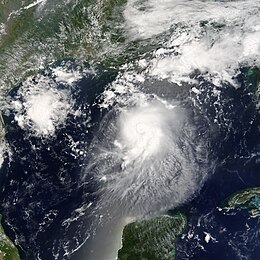Tropical Storm Bonnie (2004)
| Tropical storm (SSHWS/NWS) | |

Tropical Storm Bonnie approaching Florida
|
|
| Formed | August 3, 2004 |
|---|---|
| Dissipated | August 14, 2004 |
| Highest winds |
1-minute sustained: 65 mph (100 km/h) |
| Lowest pressure | 1001 mbar (hPa); 29.56 inHg |
| Fatalities | 3 direct, 1 indirect |
| Damage | $1.27 million (2004 USD) |
| Areas affected | Lesser Antilles, Hispaniola, Jamaica, Cuba, Yucatán Peninsula, Florida, Georgia, South Carolina, North Carolina, Virginia, Maine |
| Part of the 2004 Atlantic hurricane season | |
Tropical Storm Bonnie was a small tropical storm that made landfall on Florida in August 2004. The second storm of the 2004 Atlantic hurricane season, Bonnie developed from a tropical wave on August 3 to the east of the Lesser Antilles. After moving through the islands, its fast forward motion caused it to dissipate. However, it later regenerated into a tropical storm near the Yucatán Peninsula. Bonnie attained peak winds of 65 mph (100 km/h) over the Gulf of Mexico, turned to the northeast, and hit Florida as a 45 mph (75 km) tropical storm. The storm accelerated to the northeast and became an extratropical cyclone to the east of New Jersey. Bonnie was the first of five tropical systems to make landfall on Florida in the 2004 Atlantic hurricane season, and the second of a record eight disturbances to reach tropical storm strength during the month of August.
Bonnie's impact was minimal. Throughout the Caribbean Sea, the storm's effects consisted primarily of light rainfall, and in Florida, the precipitation caused flooding and minor damage. The tropical storm caused a tornado outbreak across the Southeastern United States which killed three people and inflicted over $1 million (2004 USD) in damage. Bonnie made landfall in Florida the day before Hurricane Charley struck.
The origins of Bonnie were in a tropical wave that emerged from the coast of Africa on July 29 and entered the Atlantic Ocean. It moved westward, attaining convection and a mid-level circulation. Convection steadily increased, and, upon the development of a low-level circulation center, the system organized into Tropical Depression Two on August 3 while 415 miles (670 km) east of Barbados. It moved rapidly westward at speeds of up to 23 mph (37 km/h); after crossing through the Lesser Antilles on August 4, it degenerated back into a tropical wave.
...
Wikipedia
